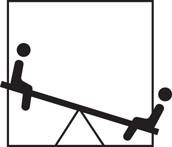
Lever Lift
How Can a Lever Help Lift Objects?
Materials
- book
- ruler
Try This
- Place the book on a table so the edge is against the edge of the table.
- Use your index finger to lift up the book.
- Now place the ruler under the book so the ruler extends over the edge of the table.
- Pressing down again with your index finger, slowly press on the part of the ruler that extends over the edge of the table. What happens to the book? Which method of lifting the book took more effort?
What's Going On?
When you pressed on the ruler, you lifted the book. It probably felt a lot easier to do than lifting the book directly. By using the ruler, you created a simple machine called a lever. A lever is a straight, stiff object, like the ruler, that pivots (turns) at a point called the fulcrum (in this case, the edge of the table). Levers allow you to move an object using less force than you would need to move the object directly. When you push one end of the lever down, the other end moves up with the same amount of force. The closer the fulcrum is to the object you want lifted, the easier it is to lift the object, because the distance that the end of the lever has to travel becomes very short for the thing you want lifted. Crowbars, nutcrackers, and even seesaws are levers. It is easier to lift your friend up on a seesaw than in your arms. If your friend moves closer to the middle of the seesaw, your friend is even easier to lift.
